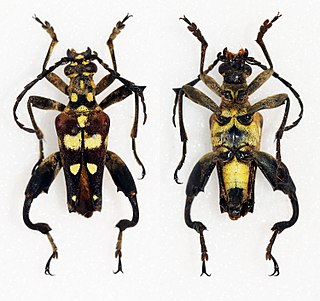
Cerambycinae is a subfamily of the longhorn beetle family (Cerambycidae). The subfamily has a world-wide distribution including: Asia, Europe and the Americas. Within the family, the only subfamily of comparable diversity is the Lamiinae.

Callichromatini is a tribe of beetles in the subfamily Cerambycinae, which includes the following genera:

Callidiopini is a tribe of longhorn beetles in the subfamily Cerambycinae.
Aedoeus is a genus in the longhorn beetle family Cerambycidae. There are about five described species in Aedoeus.
Anthribola is a genus in the longhorn beetle family Cerambycidae. There are about 11 described species in Anthribola, found in Madagascar.
Apheledes is a genus in the longhorn beetle family Cerambycidae. There are at least four described species in Apheledes, found in Madagascar.
Eccrisis is a genus in the longhorn beetle family Cerambycidae. There are about 19 described species in Eccrisis, found in Madagascar.
Icariotis is a genus of Long-Horned Beetles in the beetle family Cerambycidae. There are about 15 described species in Icariotis, found in Madagascar.
Logisticus is a genus in the longhorn beetle family Cerambycidae. There are about 18 described species in Logisticus, found in Madagascar.

Mastododera is a genus in the longhorn beetle family Cerambycidae. There are about 11 described species in Mastododera.
Pachysticus is a genus in the longhorn beetle family Cerambycidae. There are about seven described species in Pachysticus, found in Madagascar.
Pseudogenes is a genus in the longhorn beetle family Cerambycidae. There are at least two described species in Pseudogenes, found in Madagascar.

Sagridola is a genus in the longhorn beetle family Cerambycidae. There are at least four described species in Sagridola, found in Madagascar.
Stenotsivoka is a genus in the longhorn beetle family Cerambycidae. There are about seven described species in Stenotsivoka, found in Madagascar.

Stenoxotus is a genus in the longhorn beetle family Cerambycidae. There are about six described species in Stenoxotus, found in Madagascar.
Toxitiades is a genus in the longhorn beetle family Cerambycidae. There are about nine described species in Toxitiades, found in Madagascar.
Xanthopiodus is a genus in the longhorn beetle family Cerambycidae. There are at least three described species in Xanthopiodus, found in Madagascar.

The Apatophyseini are a tribe of longhorn beetles erected by Lacordaire in 1869. They are placed in the monotypic subfamily Apatophyseinae.
Cribraedoeus is a genus in the longhorn beetle family Cerambycidae. There are at least three described species in Cribraedoeus, found in Madagascar.
Lepturovespa is a genus in the longhorn beetle family Cerambycidae. There are at least three described species in Lepturovespa, found in Madagascar.






